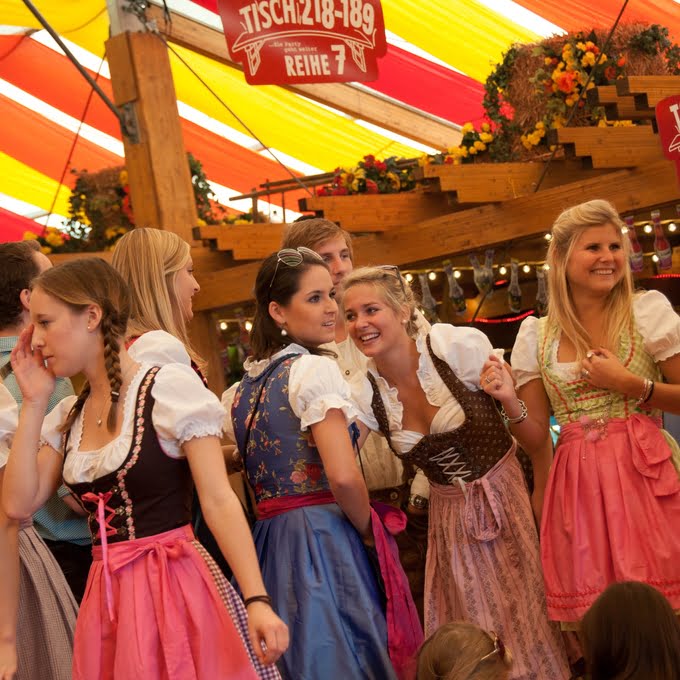This September, Stuttgart is celebrating a bicentennial double jubilee: 200 years of the Stuttgart Beer Festival along with 100 years of the Agricultural Show. The city will commemorate the founding of these two biggest festivals in the state by King Wilhelm I of Württemberg and his consort, Queen Katharina, with the Historic Volksfest that will start a few days before the agriculture and beer festivals. All of the merriment for the Historical Festival will take place on the Palace Square in the center of Stuttgart surrounded by the New and Old Palaces whereas the modern day beer festival and the agricultural festival, will be celebrated on the Canstatter Wasen, once a grassy plain not far from the city center.
On 28th September 1818, the day after the king’s 36th birthday, he founded the first agricultural show to strengthen and reform the region’s farming industry, which had been severely affected by the eruption of the volcano on the island of Sumbawa in today’s Tambora. This volcano had a big impact on Europe and resulted in the “year without a summer,” when gasses and ash caused climate changes leading to crop failures and famine in southern Germany.
The fact that 2018 is the 173rd and not the 200th anniversary of this merry traditional festival is easily explained: by order of King Karl, the Wasen was held only biennially from 1882 onwards, and this continued up to the king’s death in 1891. This, along with the repercussions of the two World Wars, resulted in Stuttgart having to go without its festival for 28 years in all.
Every four years, the agricultural festival still takes place and runs parallel to the beer festival on the Canstatter Wasen. These days, the LWH is the biggest agriculture and forestry show in southern Germany. This year, from 29 September to 7 October 2018, Stuttgart will again be transformed into Baden-Württemberg’s biggest farm. It will include a multitude of topics to do with nutrition, animals, sustainability and agriculture.
Starting on September 26, the Historical Volksfest will be the real draw this jubilee year as it will be a nostalgic view down memory lane for the locals and offer a unique look at Stuttgart’s past for the visitors. History will be the dominant feature of the celebratory Volksfest on Stuttgart main square, the Schlossplatz. Visitors can look forward to a colorful mixture of activities with fairground attractions and rides from times past, including jugglers, acrobats, old traditional crafts and farm animals. Two avenues will include fairground amusements that will be split up into the 19th and 20th century styles.
An exhibition showing the history of the local Swabian people’s biggest festival will take place around the Jubilee Column while King Wilhelm I and his wife Katharina, played by amateur actors dressed in historical garb, will make regular appearances. A festival tent with about 1,000 seats will be a focal point along with a dance floor, traditional dances and bands performing in historical clothes. Classical dishes of the era such as “Metzelsuppe,” a sausage soup, sauerkraut, boiled beef and fish on sticks, will be served with a jubilee beer made by the Stuttgart breweries, Stuttgarter Hofbräu and Familienbrauerei Dinkelacker.
Just two days later, the contemporary beer festival (often referred to as the Canstatter Wasen) gets underway! On the last Friday in September, the 28th of September, the seven beer tents, the two wine tents and the Alpine Village will open their doors to the public and the fairground rides will get under way. Round about the Fruit Column, the historic symbol of the traditional festival, 330 showmen, hosts and stallholders have a wide variety on offer. A double-looping roller coaster, autoscooters or Chair-O-Planes: modern attractions or old favourites – they’re all here at the Wasen. Hearty dishes such as grilled knuckle of pork, fried steak or Swabian “Maultaschen” (filled pasta) are served to go with the mugs of beer.
Canstatter Wasen is a benefit to Stuttgart’s economy not only for tourism but also for the local trades. Traders’ markets have a long tradition in Stuttgart and were part of the original foundation of the beer festival as the traveling tracers brought stayed to sell their goods. Even though times have changed, traders’ markets have remained and are a permanent and much-loved part of the beer festival on the Cannstatter Wasen. Visitors will also be given an insight into traditional craftsmen’s and traders’ markets showing old crafts, such as brush and basket making. In addition, household goods made of wood and other natural materials will be on sale.
As the second largest beer festival in the world after Oktoberfest, the Canstatter Wasen attracts approximately four million visitors including more than 20,000 Volksfest club members (former German emigrants and their families) from New York, Philadelphia and Chicago who regularly visit the Cannstatter Volksfest to affirm and renew their ties of friendship with Stuttgart. Benefitting from the festival are not the visitors but also bakers, butchers, suppliers, the service industry, the retail trade, hotels, transport companies and lots more businesses. According to a market survey, approximately 17,000 people are directly or indirectly involved in the Cannstatter Volksfest.






